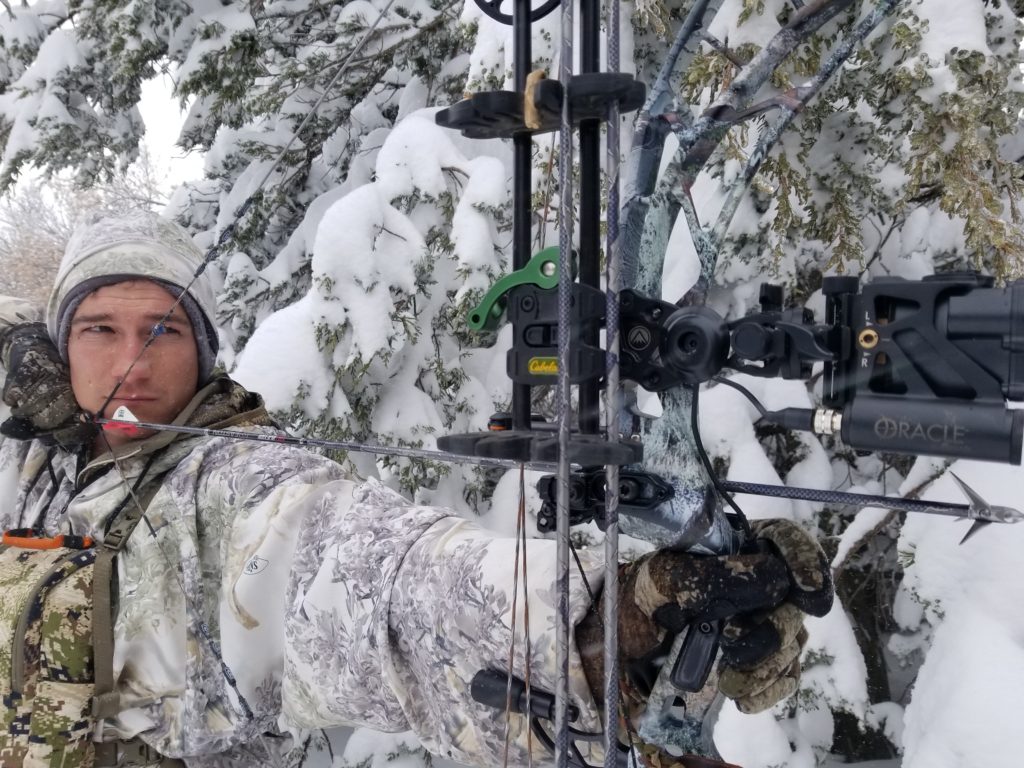The Burris Oracle Range-finding sight may be the most significant technological advance in modern archery. It’s more important than a motion-activated trail camera or the compound bow that reduces draw weight because it increases accuracy and lethality.
The Price of a Do-Over

A few years ago, I muffed the shot of a lifetime on a trophy bull elk. I was watching a wallow when I heard a fierce bugle above me. Suddenly, more bulges range out even closer. As a monster Wyoming bull stepped from the timber, he walked a trail directly toward me. Heart in my throat, I mentally prepared for a point-blank shot.
Suddenly, the bull took a right turn and drank from a stream below me. It was perfectly broadsided with its head down, but how far away? I estimated the distance and launched an arrow that flew just over its back. As if to exacerbate the-miss-of-a-lifetime, the bull took a few steps and looked directly at me. Before I could shoot again, it gave me the rump-look and walked slowly away.
Yes, range-finding sights like the Burris Oracle are pricey, yet how much would I have paid to have my sight estimate the range and take the trophy of a lifetime? Instead of a freezer full of precious, great-tasting protein and a trophy hanging on the wall, I hang my head each time I think of that blown opportunity.
Avoid Pin Confusion

Today’s hand-held rangefinders are more precise than ever and are handy to carry and use. With one click of a device in your right hand, you can determine the distance, raise your bow, select the right pin, and take the shot.
However, for that 42-yard shot, do you move down two pins or three and how far in between pins should you aim? Remember these calculations must be made at a time of great excitement and you may only have a second to calculate.
If you are a dedicated archer you know to practice at odd distances, like 27, 36, and 48 yards to that you can put an arrow precisely at the point-of-aim. The great advantage of a ranging sight like the Oracle is that you just focus on the release. The sight determines those distances exactly whether they are 30 or 37 yards.
Stand Still, Darn it!

Most savvy tree stand hunters begin memorizing distances as soon as they buckle into a stand. Using their best estimation skills or a laser rangefinder they try to commit various trees, stumps, logs, or rocks to memory. “That one is 20, over there is 30 and that last stump is 42.”
I read a post on a Bowhunting website today where an archer carries a ball of twine to his stand for each hunt. He rolls out the cord, which is marked in 20, 30, and 40-yard increments. This method can work, but what about the scent he lays down as the cord is unraveled, and what if the deer approaches from behind the stand?
Even if you know the exact distance, can you expect a buck to stop at that distance and wait for you to shoot? If the rut is in any of its phases, that deer will probably be moving, and you may have to “baaaa” at it several times to stop it. Even then you have only a fraction of a second to release, and in your mind, you may be confused about the exact distance.
Maximize Lethality

Let’s not be politically correct. Your job as a hunter is to kill that deer in the most humane way possible and that means putting an arrow precisely through its vital organs. If a deer approaches in a quartering-to angle, all of your yardage estimations go out the window as you must let it get closer, perhaps even pass by your stand so that you get a quartering-away angle. Once done, how far is the buck? Which pin to use?
I began bow hunting with a recurve and a longbow before that, so I’ve always been at the tail end of the technology bandwagon. However, I believe our ultimate allegiance isn’t to some code of hunting challenge, but to the animal itself. I want to use the most consistent bow, vertical or horizontal, the straightest arrow, and a broadhead that kills every time. If adding a rangefinding sight to that mix helps assure an ethical, quick dispatch, then I am all for it.
Perfect Practice

One of the best ways to increase your hunting effectiveness is to extend the challenge of your practice sessions. It’s fine to begin your preparation with shooting 3-D and bag targets until you can tighten your groups and tone your muscles for consistent accuracy. However, once you achieve your top shooting form, it’s time to push the envelope.
Place your target in likely hunting situations so that you are shooting from above as from a tree stand, among trees, and at varying angles. In these more challenging situations, you want your Oracle to make those yardage calculations so that you develop confidence in your ability. The sight will help control any vertical margin of error, yet if your arrows do not group horizontally, you know you are beyond your effective range.
Rick Wilson was Maryland’s state archery champ for many years and I often report his favorite practice technique. Each morning before leaving for his classroom, Wilson would step on his back porch and take one shot at a 3-D deer target. “If you miss, you can’t shoot again until the next morning,” he explained. “In that way, you will think of that shot all day. When you can put that one arrow in the vitals day after day, your confidence will soar, and you are ready to hunt.”
Check out the Burris Oracle at your nearest pro shop and research it’s many benefits online at www.burrisoptics.com





